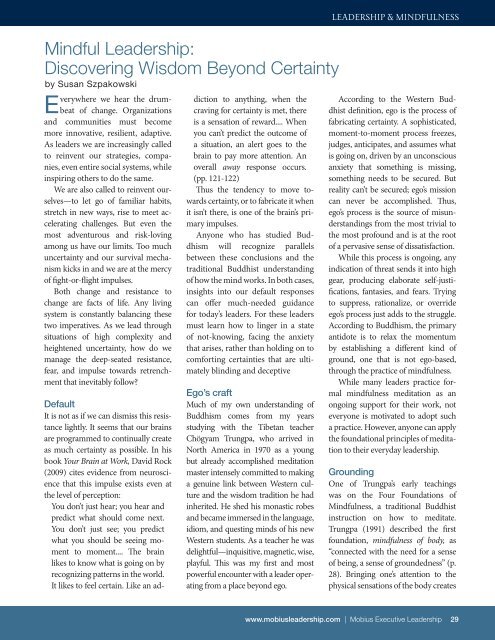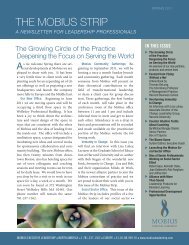Leadership & Mindfulness - Mobius Executive Leadership
Leadership & Mindfulness - Mobius Executive Leadership
Leadership & Mindfulness - Mobius Executive Leadership
Create successful ePaper yourself
Turn your PDF publications into a flip-book with our unique Google optimized e-Paper software.
Mindful <strong>Leadership</strong>:Discovering Wisdom Beyond Certaintyby Susan SzpakowskiEverywhere we hear the drumbeatof change. Organizationsand communities must becomemore innovative, resilient, adaptive.As leaders we are increasingly calledto reinvent our strategies, companies,even entire social systems, whileinspiring others to do the same.We are also called to reinvent ourselves—tolet go of familiar habits,stretch in new ways, rise to meet acceleratingchallenges. But even themost adventurous and risk-lovingamong us have our limits. Too muchuncertainty and our survival mechanismkicks in and we are at the mercyof fight-or-flight impulses.Both change and resistance tochange are facts of life. Any livingsystem is constantly balancing thesetwo imperatives. As we lead throughsituations of high complexity andheightened uncertainty, how do wemanage the deep-seated resistance,fear, and impulse towards retrenchmentthat inevitably follow?DefaultIt is not as if we can dismiss this resistancelightly. It seems that our brainsare programmed to continually createas much certainty as possible. In hisbook Your Brain at Work, David Rock(2009) cites evidence from neurosciencethat this impulse exists even atthe level of perception:You don’t just hear; you hear andpredict what should come next.You don’t just see; you predictwhat you should be seeing momentto moment.... The brainlikes to know what is going on byrecognizing patterns in the world.It likes to feel certain. Like an addictionto anything, when thecraving for certainty is met, thereis a sensation of reward.... Whenyou can’t predict the outcome ofa situation, an alert goes to thebrain to pay more attention. Anoverall away response occurs.(pp. 121-122)Thus the tendency to move towardscertainty, or to fabricate it whenit isn’t there, is one of the brain’s primaryimpulses.Anyone who has studied Buddhismwill recognize parallelsbetween these conclusions and thetraditional Buddhist understandingof how the mind works. In both cases,insights into our default responsescan offer much-needed guidancefor today’s leaders. For these leadersmust learn how to linger in a stateof not-knowing, facing the anxietythat arises, rather than holding on tocomforting certainties that are ultimatelyblinding and deceptiveEgo’s craftMuch of my own understanding ofBuddhism comes from my yearsstudying with the Tibetan teacherChögyam Trungpa, who arrived inNorth America in 1970 as a youngbut already accomplished meditationmaster intensely committed to makinga genuine link between Western cultureand the wisdom tradition he hadinherited. He shed his monastic robesand became immersed in the language,idiom, and questing minds of his newWestern students. As a teacher he wasdelightful—inquisitive, magnetic, wise,playful. This was my first and mostpowerful encounter with a leader operatingfrom a place beyond ego.LEADERSHIP & <strong>Mindfulness</strong>According to the Western Buddhistdefinition, ego is the process offabricating certainty. A sophisticated,moment-to-moment process freezes,judges, anticipates, and assumes whatis going on, driven by an unconsciousanxiety that something is missing,something needs to be secured. Butreality can’t be secured; ego’s missioncan never be accomplished. Thus,ego’s process is the source of misunderstandingsfrom the most trivial tothe most profound and is at the rootof a pervasive sense of dissatisfaction.While this process is ongoing, anyindication of threat sends it into highgear, producing elaborate self-justifications,fantasies, and fears. Tryingto suppress, rationalize, or overrideego’s process just adds to the struggle.According to Buddhism, the primaryantidote is to relax the momentumby establishing a different kind ofground, one that is not ego-based,through the practice of mindfulness.While many leaders practice formalmindfulness meditation as anongoing support for their work, noteveryone is motivated to adopt sucha practice. However, anyone can applythe foundational principles of meditationto their everyday leadership.GroundingOne of Trungpa’s early teachingswas on the Four Foundations of<strong>Mindfulness</strong>, a traditional Buddhistinstruction on how to meditate.Trungpa (1991) described the firstfoundation, mindfulness of body, as“connected with the need for a senseof being, a sense of groundedness” (p.28). Bringing one’s attention to thephysical sensations of the body createswww.mobiusleadership.com | <strong>Mobius</strong> <strong>Executive</strong> <strong>Leadership</strong> 29



